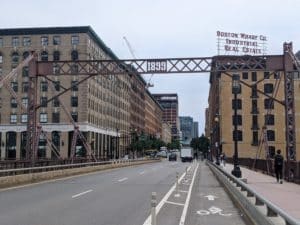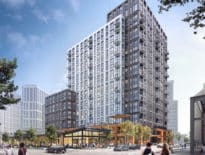
Fewer than 200 housing units were generated through conversion projects in downtown Boston since the financial crisis of 2008, hinting at the limited potential for adaptive reuse projects to address the twin challenges of office vacancies and housing unaffordability. Photo by James Sanna | Banker & Tradesman Staff
With office demand either uncertain or on the decline, chatter emerged in real estate circles about converting office space to residential use to shore up more housing amid a national shortage of inventory.
Boston’s own housing shortage crisis is particularly acute with prices perpetually on the rise, so a slew of downtown office-to-residential conversions might seem like a no-brainer. Don’t rule it out from ever happening, as there are several instances of office-to-residential conversions in Greater Boston.
But experts say it’s a little premature – and demand for life science-related conversions still too strong – to start expecting a mass wave of these kind of redevelopments.
“Office occupancies aren’t what they used to be pre-pandemic,” said Simon Butler, a Boston-based vice chairman at CBRE and who leads the New England multifamily housing investment sales team. “So maybe as people’s leases start to roll, landlords are going to be faced with some decisions they need to make about what, if it’s not going to be an office, are the alternative uses. Obviously, residential is going to be something people look at, but it’s probably early in that kind of decision making.”
Given the conservative financial strategy that drives real estate development, most commercial developers in Boston in recent years favored office-to-lab conversions. Demand for life science space exceeded demand, and the high rents associated with these kinds of tenants led to significant return on investment.
But that demand started to cool recently, Butler noted.
That presents an opportunity for more residential conversions to at least be included in the redevelopment conversations. Examples of existing residential buildings in Boston that were originally office buildings include 100 Arlington, a 128-unit apartment building in Park Square, and the Strada 234 near North Station, converted to a luxury condominium building almost 20 years ago.
More recently, The Davis Cos.-developed 100 Shawmut condo building in the South End was converted from its original office use. Eight residential conversion projects – including redevelopments like the Hamilton Co.’s 8 Winter St. conversion that netted 48 market-rate apartments – since the Financial Crisis added 190 new units to the Downtown Boston Business Improvement District, according to the BID’s second-quarter report.
Focus on Boutique, Brick-and-Beam Buildings
Older industrial buildings that converted to office use are often prime targets for residential conversion. Several former Boston Wharf Co. factories in Fort Point are now residential, said James Gray, a senior principal at Stantec.
“Their floor plates tend to be smaller than contemporary office buildings, have great bones [exposed brick and heavy timber structure] and great natural light,” Gray said in an email.
Additionally, he noted “smaller, boutique, even quirky” office buildings that are already in a residential neighborhood were viable candidates for residential conversions, as these type of office developments might suffer more in a downturn and be better positioned for a downturn.

Several ex-Boston Wharf Co. factories in Fort Point were attractive targets for residential conversions in years past because of their smaller floor plates and significant natural light. Photo by James Sanna | Banker & Tradesman Staff
But residential conversions can be easier said than done.
Architecture and design firm Gensler studied 84 commercial buildings in downtown Boston earlier this year to get a better sense of their viability for residential conversion. The Gensler study weighed factors like site context (things like walkability and access to transit), a building envelope (the wall-to-floor ratio and ease of replacing windows), and servicing (offerings like parking and loading areas).
Gensler put more emphasis on factors like the building form and floor plates, as bigger floor plates typically lead to more narrow residential units than people would like.
Long story short: Don’t expect Downtown Crossing to see an office edition of “Flip or Flop” anytime soon. Only 10 of the buildings studied garnered a rating high enough to warrant further review for potential residential conversion.
“I do think that, certainly in a city like Boston where land value is so high, that the cost to do it is somewhat prohibitive without some sort of incentives or things of that nature,” said Todd Dundon, a principal with Gensler.
Residential Conversions Potentially Tricky
Office-to-lab conversions are generally more feasible because life science uses of a building can generally maintain the office building’s layout. The boxier the better, some argue. There’s also the greater security in asking life science rents in Greater Boston, the leading life science cluster in the country as well as the tightest lab market.
Residential conversions are trickier. Office building depth is often too large for a residential conversion. While an office building’s floor-to-floor heights are usually taller than normal for a residential and could be seen as a selling point for individual units, that also adds to build-out costs more than a purpose-built residential building, Gray said.
Further, the mechanical equipment in an office building is often entirely different than what is found in a residential development, meaning a partial or entire replacement is necessary.
Office-to-residential conversions are likely to be more selective until some sort of incentive to bring down the costs enters the mix.
“Property developers make their living providing places for people to live and work based on the demand. Their projects must make financial sense for them to invest their time and capital, and to make them financeable,” Gray said. “Uncertainty is the enemy: in financial markets, interest rates, supply chains, construction costs, and entitlements are all contributors. [Developers need] help with all of that.”






